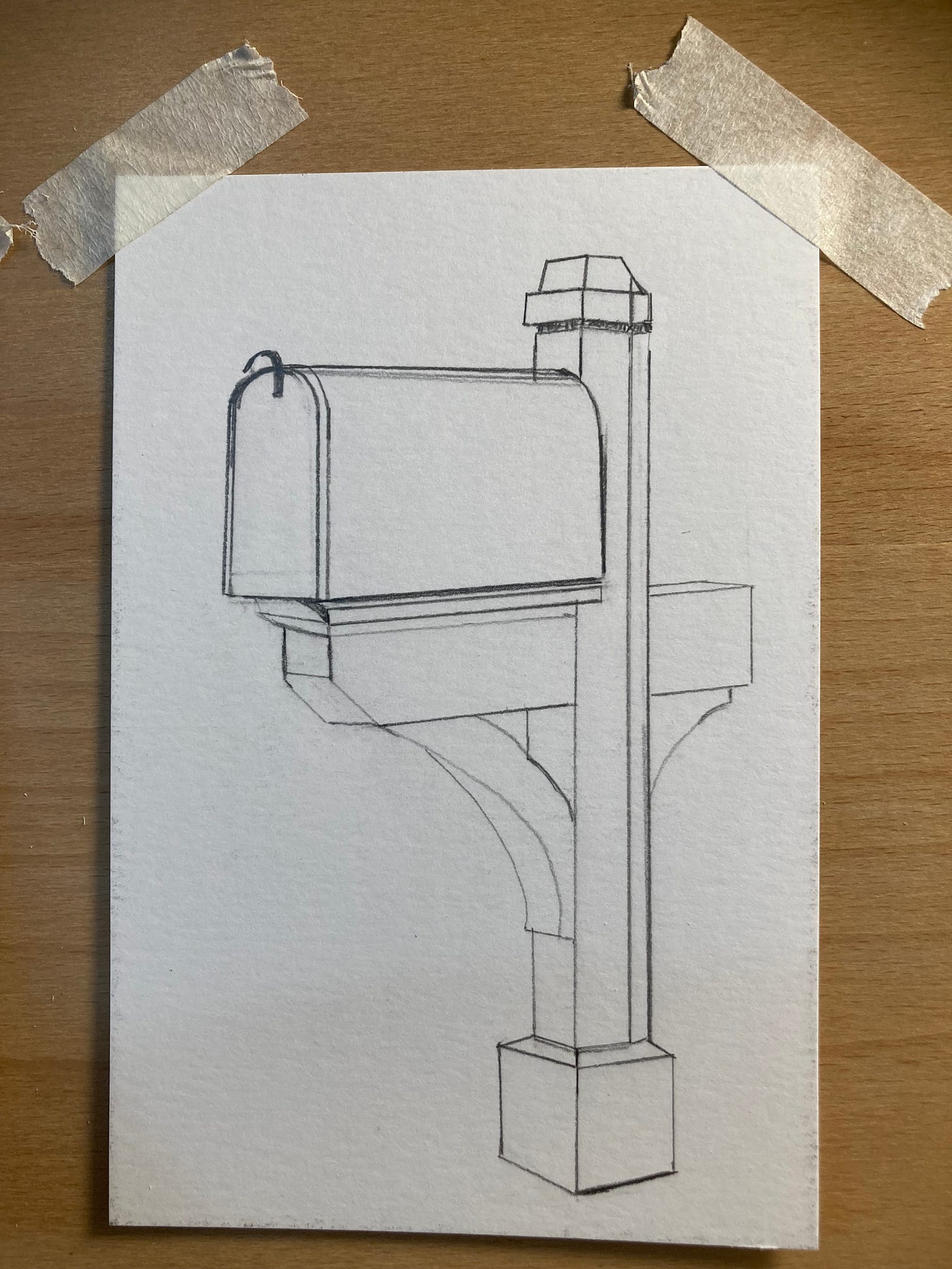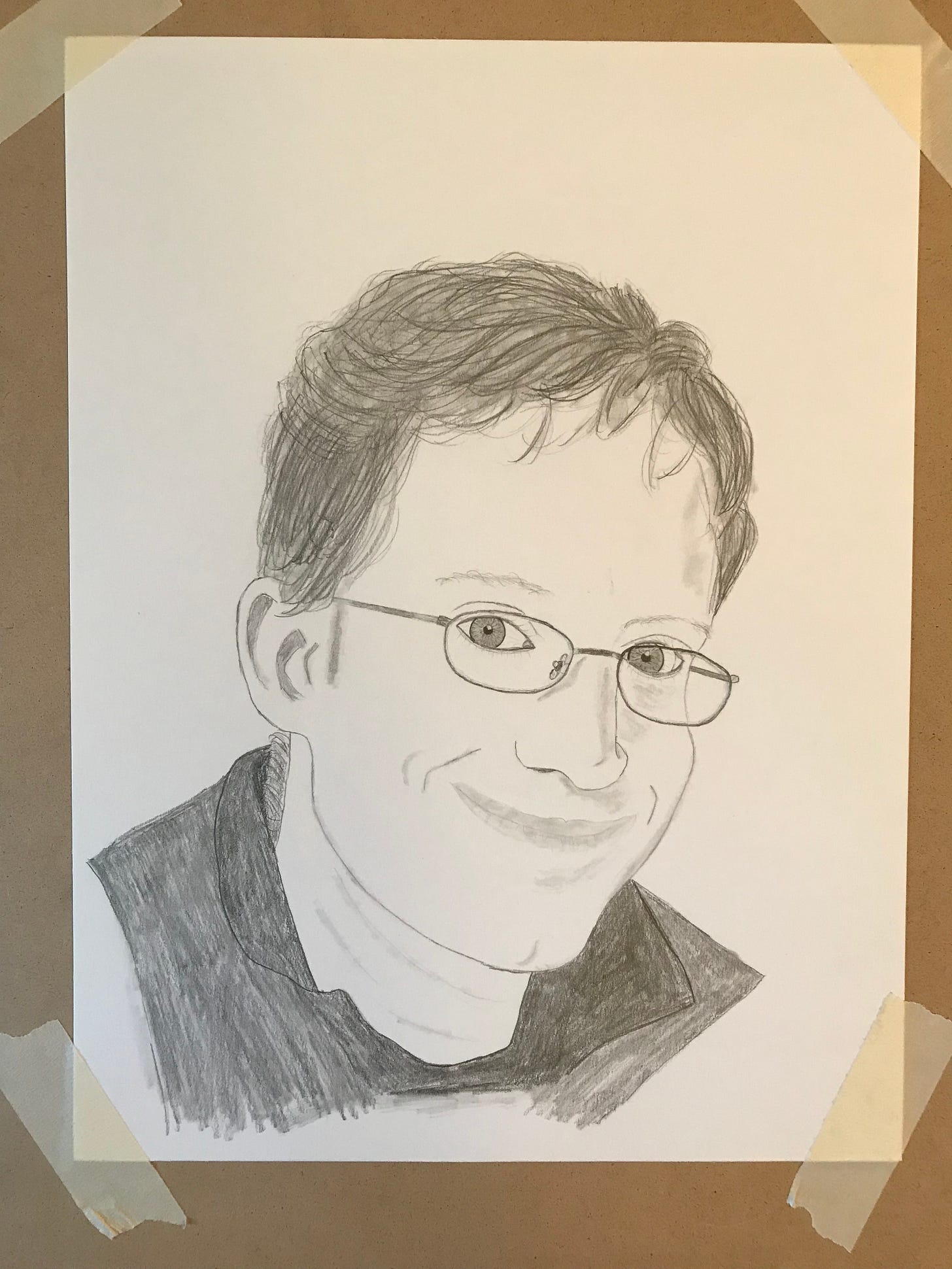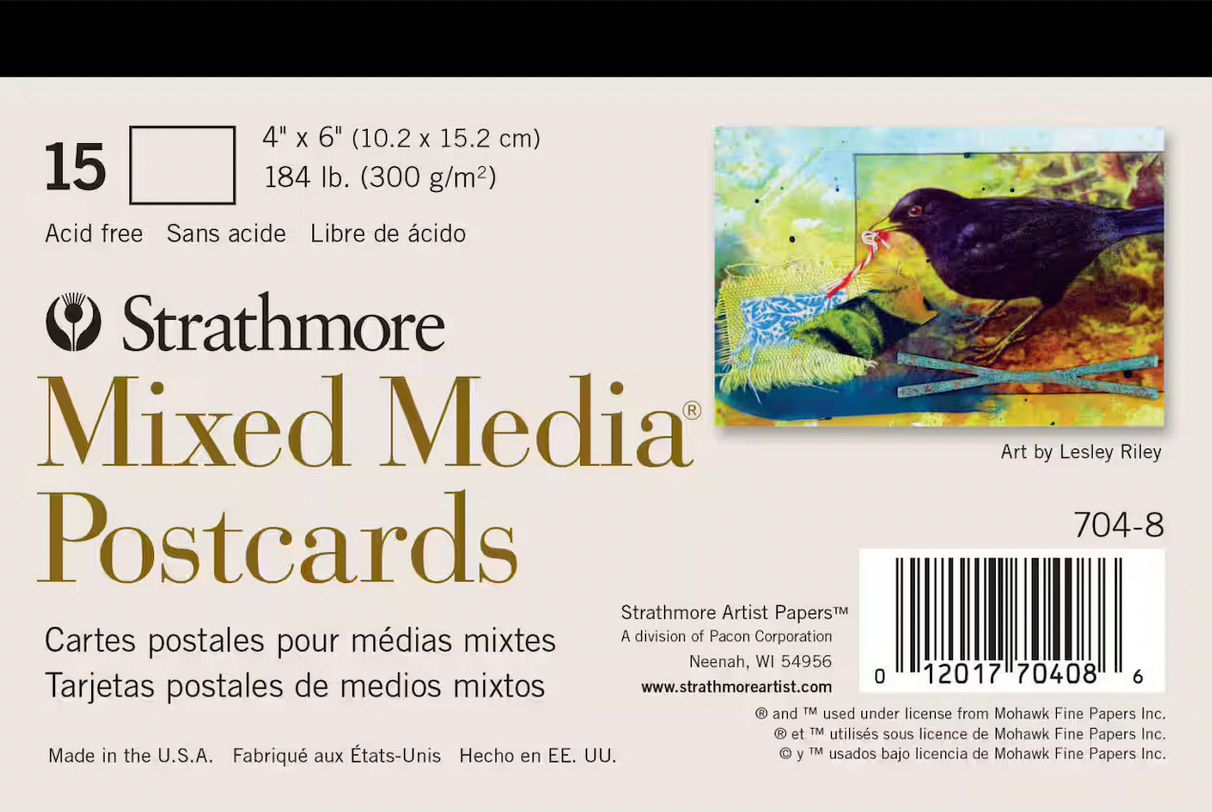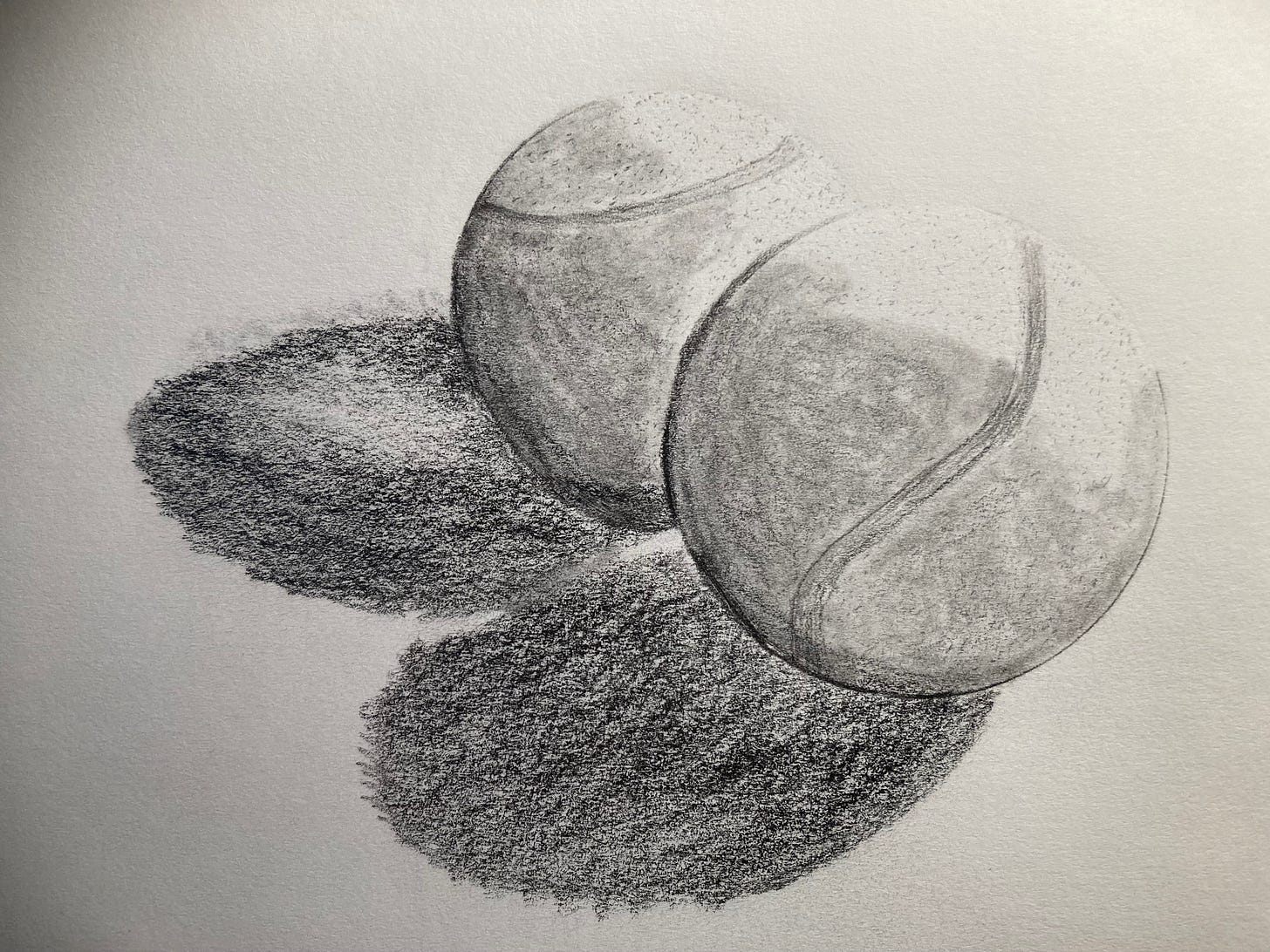Some Thoughts (and Tips) About Drawing
a creative writing post (#32)
This is a creative writing post (#32) from my occasional series for paid subscribers, who can also leave comments on most posts. As always, email hollymathnerd at gmail dot com if you would like a paid subscription but can’t afford one.
And this one has a ton of pictures, so remember you can always read it at the Substack website if your email client goes nuts with it. Look for “Some Thoughts (And Tips) About Drawing” with a posting date of May 5, 2024.
Drawing As A Hobby of Mine
I like to draw, and have been posting some of my drawings on Substack Notes, to mostly positive response. “Mostly positive” on the internet is rare enough that this is noteworthy and worth encouraging, so here are some reflections on drawing, how to learn to draw as an autodidact, and some tips.
If this post gets some traction and/or a lot of comments (indicating that readers enjoy it) I will do more on this topic. Besides my thoughts on the value of drawing as a hobby, I will go into detail about my five suggestions:
a particular 30 day course,
a helper friend,
a particular type of practice routine (I’ll share mine),
paying attention to something in particular about drawing as a hobby, and
the right supplies.
My History As An Artist
I taught (and continue to teach) myself to draw from books and YouTube videos, so my skills have always been very uneven. I’m very good at fine details, like the curls in curly hair or the veins in an eyeball. I’m also very good at using the full palette with graphite, from 10H (super thin lines, barely visible) to 9B (basically soft black carbon).
But I have always had a weakness in the area of proper perspective.
My helper friend (more on how to choose one below; they don’t need to be an artist themselves!) picked up on this and gave me some books on perspective and some drawing paper with perspective grids for my birthday last year.
With a little study and practice, my perspective drawing skills have really improved!
Here are two pictures, one in-progress and one finished-product for a perspective drawing I did yesterday:
The perspective on this one isn’t great — the cloth the lamp sits on isn’t right — but it was a great learning experience and a lot of fun. The wood grain on the wainscotting was especially fun to do.
These pictures, one before the “finishing touch” and then the final product, show the value of using the super thin, hard leads at that end of the palette. The paneling in the last step was done by using an 8H to put in some whorls and curved lines to represent variation in the wood, and then a 10H to lay in the base of the paneling itself:
For a long time, my weakness in perspective kept me only drawing people, not things. I could make people look like themselves but not things, so I stuck to what was more fun (because I felt more successful at it). Here are a few portraits I did during that period, including one of James Lindsay (in case he looks familiar to any of you, he is!).
This one has a very slight cartoon quality. I didn’t do that on purpose. It took me awhile to spot it, but I finally did — the outline of the face is too dark/harsh, and that’s why. That was a very important lesson, one that’s always stuck with me.
Graphite is my first love, but I also experiment with watercolor pencils some. These are what they sound like, colored pencils that are made to mimic watercolor paint by what you do when you’re done drawing: take a wet paintbrush and touch it to the drawing. Here are two recent watercolor pencil drawings.
My thoughts on the value of drawing as a hobby and an expansion of my five suggestions are below the paywall.
Extra space to allow for the “unlock one post free” option that Substack offers on paywalled posts, in order to give free subs a chance to see what they’re missing.
My Thoughts on Drawing
The Value of Drawing: Practical
Drawing is fun, portable, relatively inexpensive, and teaches you how to see and notice the world. I do not have natural talent for drawing. When I first started drawing, I was doing stick figures, the same as most American adults. I loved and admired the art of drawing but it wasn’t anything that felt achievable for me.
Then I happened to meet a girl who could draw really, really well. I saw her portfolio and was in absolute awe. When I expressed my jealousy and admiration of her talent, she told me that it wasn’t really a talent, it was a skill. Her words were pivotal for me:
“People who think they can’t draw, especially people who really, really wish they could, nearly always try to draw people and things. That’s why they can’t do it; it doesn’t work that way. You have to learn to see, and draw, lines and shadows. That’s it. Once you learn to see everything as lines and shadows, the rest is just practice.”
I took her advice to heart and started trying to see lines and shadows. In one day, I could draw significantly better than I ever could before. That one paradigm shift was more powerful towards my improvement than anything else ever has been, by far.
Now I see the lines and shadows in the world around me, which helps me see their relationships more clearly, which is hugely valuable in and of itself.
Google Image searches will let you find a reference photo for almost anything, but I also often take my own reference photos (with my smartphone; nothing special).
The Value of Drawing: Psychological
Drawing, for me, is a very different type of hobby from writing. I typically clarify my own thoughts by writing. I often have a sense of wanting to express something big — for example, my support for Israel in its war against Hamas — but not knowing exactly why that big thing is important to me or what aspects of that big thing matter to me. Sometimes I will have a vague connection in my mind but not be clear on its significance. (For example, when I sat down to write this essay, I knew only that there was something in a beloved childhood book that was connected to what I was seeing in both mainstream and social media. I didn’t know what it was, or why it mattered to me.) The fun is in the discovery, and I’m often surprised with what I have when I’m done.
Drawing is almost the perfect opposite of this. I start with a clear idea of what I want the finished product to look like, then see how close I can get. I know the finished product will never be perfect, and the fun is in what I learn along the way of trying to get there.
Drawing is also a powerful anti-depressant. Creativity—which I am defining here as doing something that gives you, when you’re done, something that didn’t exist when you started—is life-affirming in a way that very few other things are.
My Five Tips for the Would-Be Autodidact
Tip 1: A Particular 30 Day Course
Mark Kistler’s book, You Can Draw in 30 Days, is absolutely marvelous. Get the Kindle version (there’s an app for your laptop or desktop; you don’t have to own a Kindle) so you can have the lesson up on a screen to refer to. It will send your skill level up like a rocket, and it’s really fun. Most lessons can be done in 20 minutes or less.
Tip 2: A Helper Friend
A sharp-eyed friend, even if he or she doesn’t draw himself or herself, is a really powerful way to improve. When you’ve spent a long time on something, your ability to see it clearly diminishes. One of my good friends (the same one who got me the pads and books to help me improve my perspective) does this for me often. I show him many of my drawings and the reference photos I used, and he is able to point out what works well and where I went wrong.
Tip 3: A Particular Practice Routine
My practice routine changes with the circumstances of my life. When I’m unusually busy or stressed, I just try to do a practice exercise or two (like the one below) at least every couple of days. When I’m really prioritizing making time to draw, as I am now (for reasons I’ll disclose in a minute) then I’ve found a project approach to work really well for me. I choose something big to work on that will give me a sense of satisfaction at each stage. Or, as I’m doing now, I impose on the kindness of friends. Finishing one small drawing a day is working really well for one of my larger goals, so I’ve been sending these off to friends as postcards. (If you’re one of my real-life friends and you haven’t gotten one yet, hang in there—I’m out of stamps and there are several on my desk.) This works great for me because I often have a hard time expressing my feelings more directly, and my friends (correctly) interpret them as expressions of love. And it’s fun to get something besides a bill in the mail.
I like Strathmore Mixed Media postcards, as they can handle a little water if I’m going to draw something in watercolor pencil, and they’re sturdy enough to survive a trip through the mail.
Tip 4: Pay Attention to Something in Particular
I’ve talked to several other people who draw regularly, and they’ve all noticed the same thing I’ve noticed. Drawing seems to unlock something in my brain. I have a much easier time working on my novel, solving coding problems, making progress on personal problems, and otherwise accessing creative ideas when I’m drawing regularly. Maybe it’ll work that way for you, too. If you pay attention and find this to be the case, it can be really motivating — and help justify the time and expense (which, drawing with graphite pencils is the cheapest artistic hobby, but you do need to buy a few things).
Tip 5: The Right Supplies
Besides a ruler and a few stencils, so you can do perfect circles and ellipses, all you really need are pencils, paper, sharpeners, erasers, blending tortillons, a brush (so you won’t spit on your drawings by accident when you blow shavings off), a small tabletop easel (so you won’t distort your drawings by working flat), and artist’s tape (to hold your reference photos and drawings to the easel without damaging them). When you’re ready to start saving your drawings, you’ll also want some workable fixatif (a spray that keeps drawings from smearing). I like kneaded erasers but also cherish my electric eraser, which erases even very dark marks fully. It has a little shield that can be used to protect a drawing and erase another mark entirely.
Professional pencils are about $2 each. I do find that they’re worth the money. To start, you should get one each of 10H, 8H, and 8B, two each of 6H, 4H, 2H, HB, 2B, 4B, and 6B. (There are odd numbered ones too, that fit in between the values of each of these—9H, 7H, etc.—but you likely won’t use every possible value in the beginning). Paper has ratings. 300 rating is good, 400 is better, and 500 is for pros who need their drawings to hang in museums for the next two centuries. I use 300 for most things but keep a pad of 400 in the closet for the occasional circumstances when I am making someone a gift or have taken a commission.
The most expensive item is the tabletop easel, a one-time expense (as are the stencils, and a box of sharpeners and tortillons both last long enough that they’re basically every-other-year expenses). Hobby Lobby and Michael’s both rotate what department is on sale each week. If you go to one of them when drawing supplies are on sale, you can get everything I’ve listed here at the lowest possible price to get started. Then going forward you’ll only need to replenish the paper and erasers with any regularity.
Some pictures below of the supplies I use.
Conclusion
Drawing is enormously fun and the best anti-depressant I know of that can be accessed alone. It’s a fun hobby that’s relatively inexpensive and easy to pick up from YouTube and/or a few books. Happy Drawing!






















Thanks for this post, will refer to it for reference.
Here is what has worked for me, especially when creatively 'stuck'. What all of these do (for me) is stimulate the imagination, suspend self-judgment, and force me to create the lines, shades, and moods with limited tools in a space and time that doesn't overwhelm me.
- Drawing (or painting) with the non-dominant hand (for me, the left hand) only.
- Not starting with an endpoint or subject in mind, just seeing where the drawing takes me.
- Working in small sizes (even postcard size or smaller) to force a time limit .
- Limiting my choice of pen, pencil, marker or ink to 1 type of thickness.
- Limiting my stroke to lines or curves or dots.
- Limiting choice of colors to only primary red / yellow / blue and mixing to get other variations, or limiting to white and black and mixing to get grayscale.
When I shared your drawing of the oil lamp, people remarked especially on how much they liked the grain in the wainscoting.